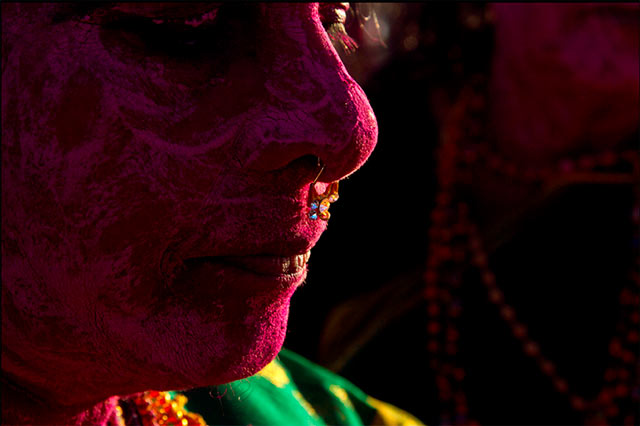
The Indian Nose Ring: A diamond studded Indian nose ring, glitters in the calm morning light. People in disguise, give utter most importance to very minute details, such as nose rings, eye lashes, lipsticks, and necklaces.
Half a million Indians throng the otherwise quiescent coastal village of Kulasekarapattinam in Tamilnadu, India every year to celebrate Dasara (Dasha-hara in sanskrip means “remover of bad fate”). It’s an annual festival of the warrior Goddesses Muthuramman that is celebrated on the tenth day of the Ashvin month – during September or October according to the Hindu calendar. The devotees transform themselves to become Gods, Goddesses, Demons, Kings or animals, and offer their prayers to the Goddesses. It’s a celebration that offers any photographer the occasion to document a city that is in full festival mode.
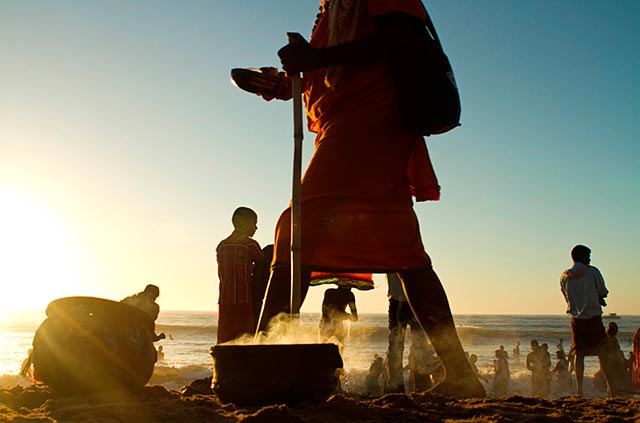
Holy Torch: The Holy torch carried by the devotees is left behind on the burning sand of the beach. On reaching the Holy temple, devotees visit the beach, located approximately a mile away, to conclude their fasting and offer prayers to the Almighty.
India, a country more popularly known for its infinite gods, rituals, languages, and art forms, might as well be described as a land of festivals. Indians over many centuries have developed a deep rooted, unshakable faith in festivals as a glorious means of celebrating love, life and friendship. Hinduism, one of the oldest known religions, preaches the importance of worshipping “Shakti”, the embodiment of power. Both Shakti (woman) and Siva (male) are inseparable omnipotent forces of the cosmic world and share a symbiotic relationship.
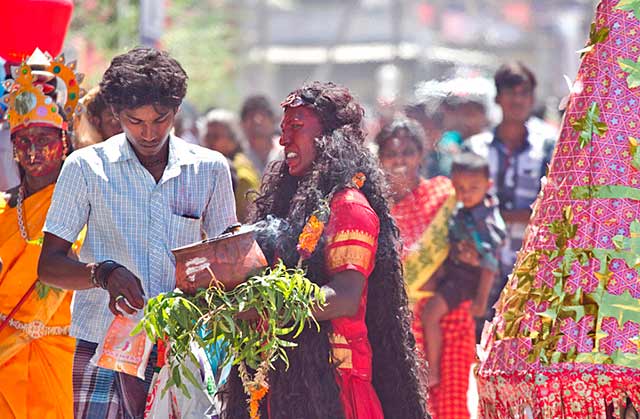
God’s Walk – Goddess Durga
The story of demon King Mahishasura, the one that tormented heaven, the oceans and hell, and granted the benefit of immortality from the Supreme God, is popular.
Goddess Durga (“The one who eliminates suffering.”), the incarnation of power and vigor, fought a battle with the demon for over nine days. On the tenth day she slaughtered the demon and thus the victory of Good over Evil was established.
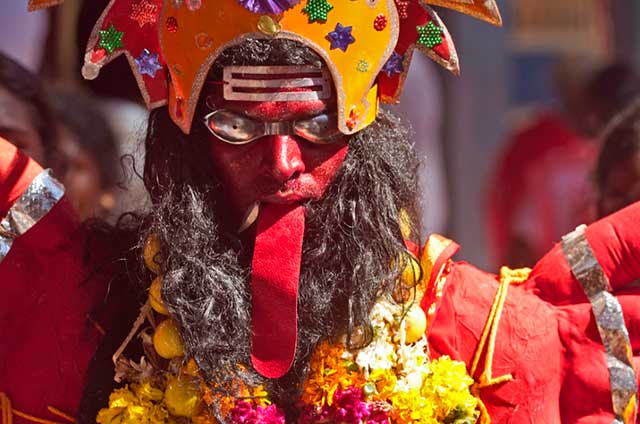
Goddess Durga – The drooping tongue represents blood thirst and sticking her tongue out in shame.
The 300 year old temple of Goddesses Muthuramman is yet another form of that Shakti or Durga that slayed the demon king’s eon to bring peace in the world. Dasara therefore is a celebration of this very victory of good over evil and takes a unique local form.
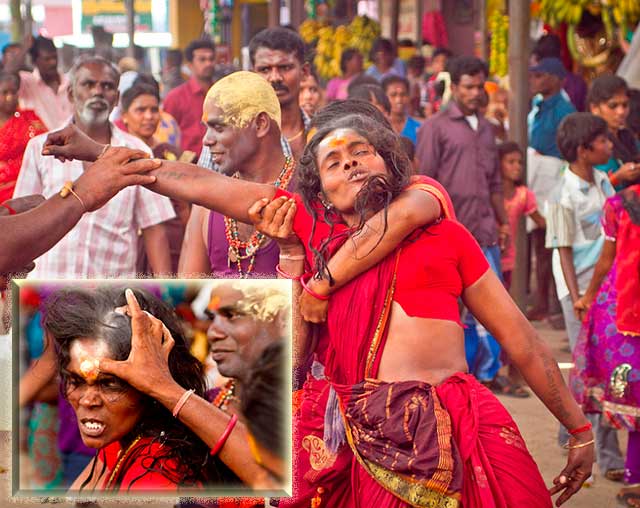
In Trance: Women, more often than men, experience certain trance like states during the processions. The temporary state of mind is referred to as possession by God. They are worshipped by bystanders and some turn into fortunetellers as well.
Should you have the opportunity to go to Tamilnadu to photograph this ten day festival, you won’t be disappointed with the experience. Dramatic images full of colorfully decorated devotees in celebration are at you finger tips around every corner – young and old alike.
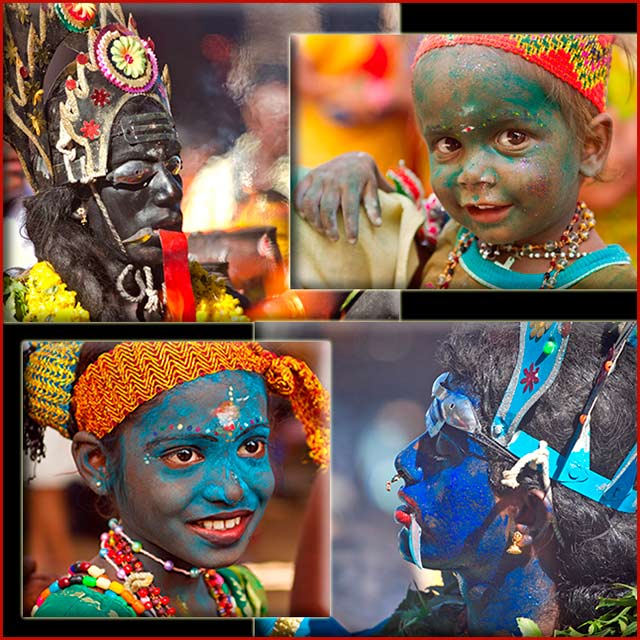
Top left: – An up close look of Goddess Kali, with popped out tongue, metallic eyes, holy pot of fire and devotion in his heart. The procession enters a whole different scale on reaching the sanctum sanctorum.
Top right – One Color: A 2 year old child, smeared with colors of green and red, seen with her only sister at the procession. The festival is equally celebrated by all ages and colors.
Bottom left – Young Prayers
Bottom Right – The Fiery: With mercury rising, vapors from the holy pot of fire, held in the hands of a devotee fill the frame. The make-up and the attire stay on the person for at least a day and a half.
With much perseverance and utmost devotion, moreover with equal faith in an age-old system, you’ll photograph devotees in their carefully attired masks and costumes walking in a procession of sorts, dancing and chanting the names of the Goddess. They move inch by inch among the crowds of people in the scorching sun to offer their prayers and ask for blessings.
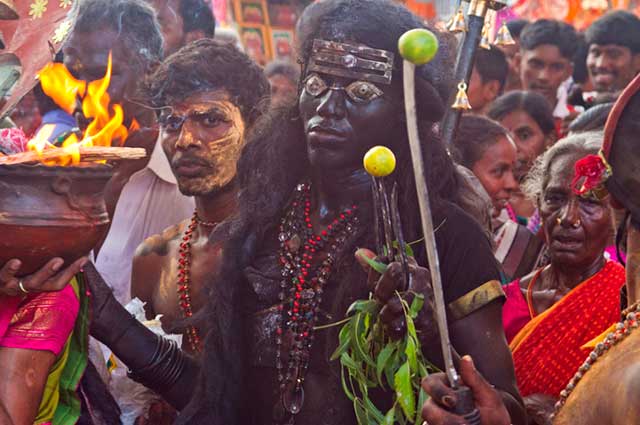
On Arrival – Goddess Kali
(Black Goddess: Sanskrit meaning “She who is death.”)
Most notably, you will be making images of those dressed up as Goddesses Durga; picture brightly painted bodies, make-shift skulls of plastic and innumerable hands with weapons of destruction and earthen pots filled with fiery charcoal, in their outstretched arms.
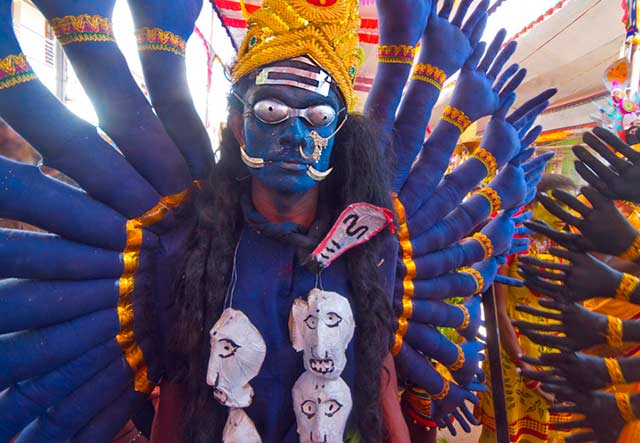
The Immortal – Goddess Kali with many arms that represent work and being liberated from the Karmic cycles.
Interestingly, though considered to be a festival for women, a staggering 80% of the people who dress up as the Goddess Durga are sturdy men. 48 hours at a stretch, fatigue soon hits these men in disguise.
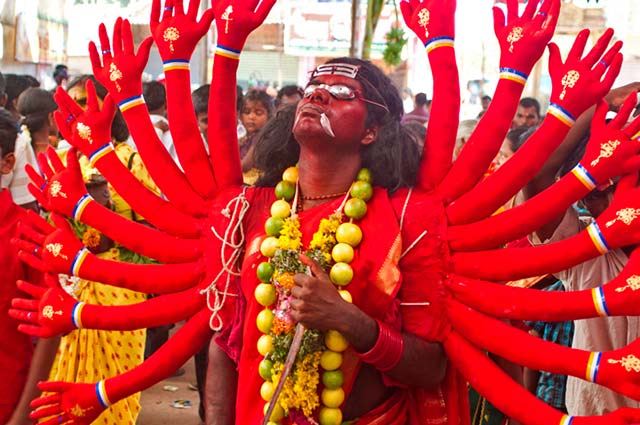
The Rancorous: Goddess Durga’s many arms represent the eight quadrants or ten directions in Hinduism, suggesting that she protects the devotees from all directions.
This tradition seems to tame the rustic angry young and make them strong by channeling their pain into religious practices of resilience and penance. It seems ironic that they surrender to God to annihilate pain from their lives by subjecting themselves to painstaking and gruesome rituals and customs. By impersonating Goddess Durga, they seem to believe that good can be resurrected in this world of turmoil. Who knows, maybe they are right!
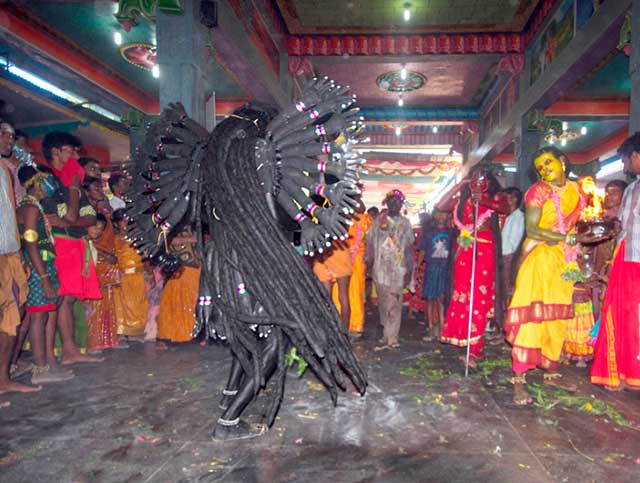
Godly Dance: A full avatar of Goddess Kali could be seen here. With thick long hair, numerous hands, each adorned with weapons – she is considered to be Embodiment of Power.
Should India be one of those locations on your photographic bucket list, you may want to consider scheduling you visit during this incredible festival.
by Kris Hariharan
Text and Photos: © 2013 Kris Hariharan. All rights reserved.

Leave a Reply